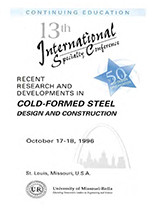Session Dates
17 Oct 1996
Abstract
At an interior support, sections of cold-formed steel are subjected to a concentrated load and a bending moment Existing design rules describing the section failure at an interior support are subject to improvement and are not based on the section's physical failure behaviour. In the last decade, several analytical models have been developed that predict the section ultimate concentrated load and directly include the influence of the bending moment, so that an empirical interaction method is not needed. However, the authors believe that these models are correct only for a concentrated load and a small bending moment In practice large bending moments occur. Therefore, the aim of the current research project is to develop an analytical model for trapezoidal hat sections subjected to a concentrated load and a bending moment as occurring in practice. The development of this model will be based on both experimental and numerical research will be carried out. In this article, a part of the experimental research will be presented.
Department(s)
Civil, Architectural and Environmental Engineering
Research Center/Lab(s)
Wei-Wen Yu Center for Cold-Formed Steel Structures
Meeting Name
13th International Specialty Conference on Cold-Formed Steel Structures
Publisher
University of Missouri--Rolla
Document Version
Final Version
Rights
© 1996 University of Missouri--Rolla, All rights reserved.
Document Type
Article - Conference proceedings
File Type
text
Language
English
Recommended Citation
Kerstens, J. G. M.; Snijder, H. H.; Bakker, Monique; and Hofmeyer, H., "Experimental Research on the Behaviour of Combined Web Crippling and Bending of Steel Deck Sections" (1996). CCFSS Proceedings of International Specialty Conference on Cold-Formed Steel Structures (1971 - 2018). 2.
https://scholarsmine.mst.edu/isccss/13iccfss/13iccfss-session4/2
Experimental Research on the Behaviour of Combined Web Crippling and Bending of Steel Deck Sections
At an interior support, sections of cold-formed steel are subjected to a concentrated load and a bending moment Existing design rules describing the section failure at an interior support are subject to improvement and are not based on the section's physical failure behaviour. In the last decade, several analytical models have been developed that predict the section ultimate concentrated load and directly include the influence of the bending moment, so that an empirical interaction method is not needed. However, the authors believe that these models are correct only for a concentrated load and a small bending moment In practice large bending moments occur. Therefore, the aim of the current research project is to develop an analytical model for trapezoidal hat sections subjected to a concentrated load and a bending moment as occurring in practice. The development of this model will be based on both experimental and numerical research will be carried out. In this article, a part of the experimental research will be presented.



